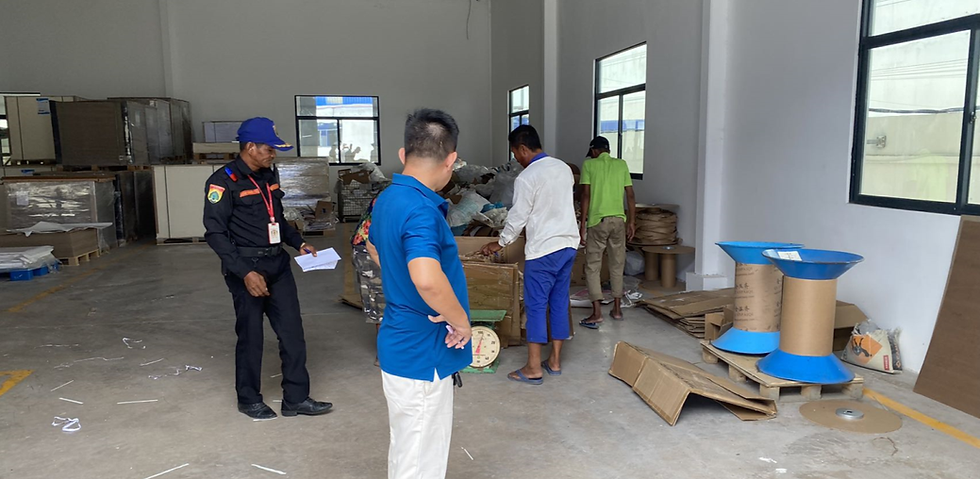A Complete Guide of Recycled Notebooks 2025
- Leo Xia

- Jun 6
- 5 min read
Quick Content Reach:
Opening: Why This Guide Matters to Large-Scale Buyers
If you manage notebook assortments for a supermarket chain, import office supplies for Amazon FBA, or spec private-label planners for your brand, recycled notebooks are no longer a “nice-to-have.” Global demand for recycled paper is projected to climb from USD 38.9 billion in 2025 to USD 53.7 billion by 2033—a 4 %+ CAGR—driven by corporate ESG mandates and end-user preference for sustainable goods. straitsresearch.com Failing to offer a credible recycled line leaves both revenue and reputation on the table.

Market Outlook 2025: Numbers You Can’t Ignore
Source: Straits Research; Business Research Insights straitsresearch.combusinessresearchinsights.com
Take-away: By mid-2025 nearly half of U.S. shoppers actively seek sustainable options. Stocking recycled notebooks is no longer niche—it’s mainstream risk management.
What Actually Counts as a “Recycled Notebook”?
Post-Consumer Waste (PCW) Content – Paper fiber reclaimed from end-user recycling streams. Common thresholds: 30 %, 70 %, 100 %.
Pre-Consumer Waste – Trimmings and misprints captured on the mill floor. Still helpful, but carries less marketing weight with regulators.
Certification – Look for FSC® Recycled labels or independent mill certificates; these protect you from green-washing claims.
Traceable Chain of Custody – Digital batch codes that link each notebook back to bale ID and mill date—essential for large retailers undergoing ESG audits.

Key Materials in 2025
Trend watch: Agro-waste fibers (bagasse, wheat straw) grew 18 % YoY in 2024 thanks to Asia-Pacific mill investment. gminsights.com
How Lion Paper Turns Waste Into Write-Ready Pages
As CEO, I’ve overseen our China + Cambodia dual-factory model since 2015. Here’s our recycled line workflow:
Mill Partnerships – We lock annual tonnage with certified mills in our raw material suppliers, securing PCW content and price stability.
Closed-Loop Cutting – Precision guillotine systems achieve ±0.2 mm tolerance, minimizing fresh trim waste.
Low-VOC Printing – Heidelberg Speedmaster presses run soy-based inks, cutting VOC output by 63 %.
Visual QA – Each binding station streams video to our Jiaxing QC hub.

Recycle Wasted Materials
Performance vs. Virgin Paper—Myth Busting
Result: The only practical delta is 1 – 2 % opacity loss—imperceptible in normal use. Our U.S. university client replaced 280 k units without a single returns spike.
Cost Analysis Example: Where Recycled Pays Off
Assumptions: 5 × 8 in, 120 pages, wire-O, FOB Shanghai.
Break-even: For national retailers, the 5–7 % premium is usually offset by 12–15 % higher sell-through in “green” aisles plus eligibility for sustainable-product merchandising funds.
Regulatory Landscape Snapshot (July 2025)
United States – FTC’s Green Guides revision (draft) proposes fines up to USD 50k per SKU for unsubstantiated “100 % recycled” claims.
EU – Under the revised Packaging & Packaging Waste Regulation (PPWR), large importers must hit 35 % recycled content in stationery by 2030.
Australia – The 2025 National Packaging Targets require 100 % of packaging to be reusable, recyclable, or compostable. Notebooks with plastic shrink-wrap will face retailer pushback.
How to Source Recycled Notebooks Without Quality Trade-Offs
Demand Mill Certificates – Verify PCW %, ISO 14001 compliance, and elemental-chlorine-free status.
Audit the Bindery – Look for automatic punching and visual-positioning systems; manual setups often mis-align recycled stocks.
Check Ink Compatibility – Recycled sheets can be more absorbent; require low-VOC but high-density pigment formulations.
Insist on Video QA – Live feeds deter corner-cutting and reduce incoming-inspection costs.
Factor Tariffs & Duties – Cambodia’s temporary 90-day tariff reprieve ends July 9 2025; plan shipments or dual-source via our Jiaxing plant accordingly. virtuemarketresearch.com
Case Study: A European Wholesaler’s Carbon-Neutral Gift Set
Client: UK office-supply chain (300 stores)
Challenge: Replace virgin-paper diaries with recycled versions while hitting a 15 % margin.
Solution: 85 % PCW interiors, wheat-straw covers, soy ink, eliminated individual polybags.
Outcome: 12 % landed-cost savings via bulk ocean freight + 22 % YoY sales lift; earned the retailer a spot in a Defra “Green Workplace” pilot.
Buyer’s Checklist—Ask These Before You Sign
What is the verified PCW percentage?
Do you hold FSC Recycled or equivalent certification?
Which binding machines handle recycled stock (brand & model)?
How do you control humidity and curl during warehousing?
What is your fallback plant if tariffs or capacity issues arise?

Future Trends Beyond 2025
Conclusion & Next Steps
Recycled notebooks are no longer just a CSR talking point—they’re a profit lever, a compliance shield, and a brand-building story rolled into one. As someone who has spent two decades guiding retailers and wholesalers through notebook supply-chain pivots, I can say with confidence: the winners in 2025 will be those who lock in recycled capacity before lead times spike.
—Leo Xia, CEO, Lion Paper Products
FAQs:
Q1: What is the minimum PCW percentage to qualify as a recycled notebook?
A: Most retailers accept 30% PCW as the baseline, but 70–100% is preferred for eco-labels and compliance audits.
Q2: Will recycled paper notebooks cause ink bleeding or ghosting?
A: Not if properly manufactured. Lion Paper uses 90 gsm+ paper and tests for fountain-pen compatibility to prevent bleed-through.
Q3: Are recycled notebooks eligible for import to the U.S. or EU under current regulation?
A: Yes. Lion Paper notebooks meet ISO9001, FSC Recycled, CPSIA, and EU environmental standards.
Q4: What binding options are suitable for recycled paper?
A: Wire-O, casebound, and saddle stitch all work well. Lion Paper uses automated punching machines for precision binding.
Q5: Can I customize recycled notebooks with my brand logo and design?
A: Absolutely. We offer full custom services—cover design, interior layout, debossing, foil stamping, and more.
Q6: Will recycled packaging be included with the notebooks?
A: Yes. We offer kraft paper bands, FSC-certified cartons, and optional plastic-free wrap.
Are you looking for a reliable manufacturer? Reach out to Lion Paper for a free quote and consultation. Let’s collaborate on creating custom writing paper products that will set your brand apart from the competition.






Comments